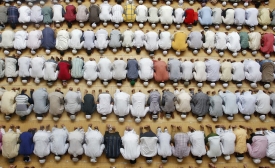india
The latest spate of terrorist attacks in the Middle East and Bangladesh and the unfortunate, indiscriminate killings in Paris have highlighted how misinterpretation of culture, rituals and religious beliefs are affecting peace and stability all over the world. It has also drawn attention to the politicisation of faith and its consequent repercussions. [...] This process [of cultural diplomacy] is reducing the impact of differences in cultures becoming catalyst for conflict.
When an Indian man invented a simple machine for poor rural women to make cheap sanitary pads, the idea was to provide jobs for some, and hygiene for millions - often for the first time. The story gave one British woman an idea that quickly became her mission in life.
The Islamic State of Iraq and Syria, or ISIS, is a new kind of threat facing the world today. ISIS takes advantage of their huge social media audience to post narratives of radicalization and brutality, to terrorize people, and to spread their philosophy to attract supporters worldwide. Thus, a new form of terror via cyber space, or “terrorism 2.0,” has emerged.

On India's strategic communications to foil ISIS.
In the past two months, India must conclude, sadly, that its story on Nepal is not winning and its soft power is being eroded on a daily basis. This weekend’s events, with the temporary detention of 13 Seema Sashastra Bal personnel by Nepal’s Armed Police Force personnel and the Nepal government’s decision to take Indian channels off air, only drive the point home that Nepal is rejecting India’s power, both hard and soft.
Pakistan-India cricket matches have also offered opportunities for cricket diplomacy as a means to improve relations between the two countries by allowing political leaders to exchange visits and cricket followers from either country to travel to the other to watch the matches.
To showcase that bond through art-works, Art Beyond Borders is organising a group show titled- Integrated Art ‘India…..Bangladesh” which has 20 contemporary artists participating from Indian and Bangladesh participating in it. [...] “we aspire to bring all the eight SAARC nations on the same platform with art and cultural exchange and hope to fill the void left behind by sub continental politicking and diplomacy
Instead, she will be a great power through building her own strength and capabilities and continuing to show wisdom and good sense in her choice of engagements abroad. [...] I am convinced that India will be a great power if she continues on her present course. This will not be through her soft power.







